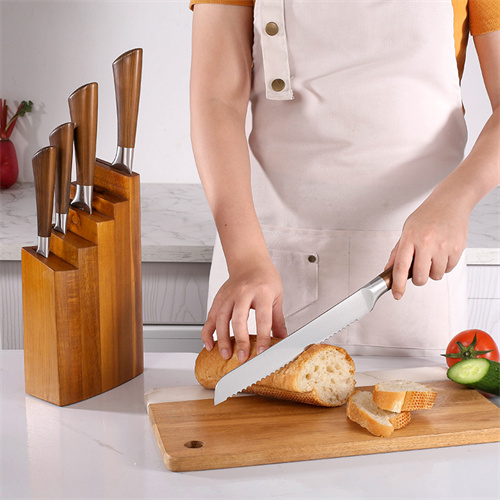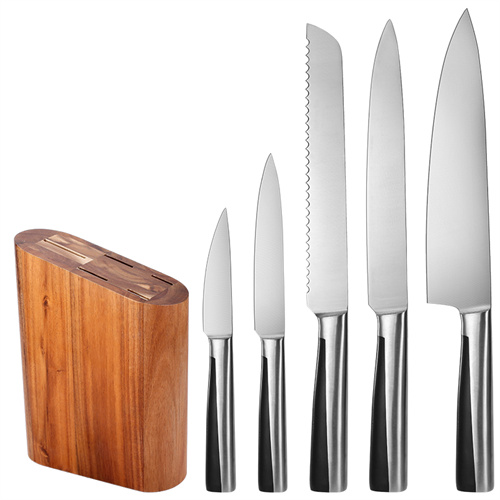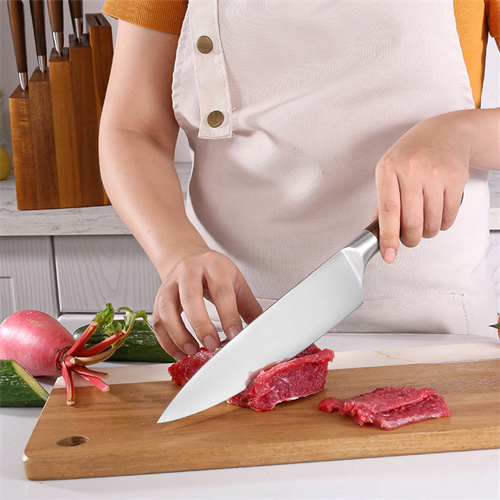

Views: 690 Author: sales@insightknife.com.cn Publish Time: 2025-01-17 Origin: Site








Content Menu
● The Impact of Using a Dull Knife
>> Food Preparation Challenges
>>> Messy Results
● Maintaining Your Kitchen Knives
>>> Knife Blocks and Magnetic Strips
>>> Use the Right Cutting Surface
● Frequently Asked Questions regarding Kitchen Knife
>> 1. What are the common causes of a knife becoming dull?
>> 2. How can I tell if my knife is dull?
>> 3. What are the safety risks associated with using a dull knife?
>> 4. How often should I sharpen my kitchen knives?
>> 5. What is the best way to store kitchen knives to maintain their sharpness?
A dull kitchen knife is more than just an inconvenience; it can significantly impact your cooking experience and safety. Understanding the defects associated with dull knives is essential for anyone who spends time in the kitchen. This article will explore the various aspects of dull kitchen knives, including their effects on food preparation, safety concerns, and maintenance tips to keep your knives sharp.
A knife becomes dull when its edge loses its sharpness due to regular use. The blade's edge is not perfectly straight; instead, it has microscopic serrations that allow it to cut through food. Over time, these edges can become rounded or chipped, making it difficult for the knife to slice through ingredients effectively. Factors contributing to dullness include:
Frequent Use: Regular cutting, chopping, and slicing can wear down the blade. Each time you use a knife, it encounters resistance from the food, which gradually alters the edge. This wear and tear accumulate over time, leading to a noticeable decline in performance.
Improper Storage: Storing knives loosely in a drawer can cause them to collide with other utensils, dulling the edge. When knives are not stored properly, they can knock against each other or other kitchen tools, leading to nicks and dull spots on the blade.
Cutting Surface: Using hard surfaces like glass or stone can damage the blade more quickly than softer surfaces like wood or plastic. The hardness of the cutting surface can create micro-chips in the blade, which contribute to dullness and affect the knife's ability to cut cleanly.

Recognizing a dull knife is crucial for maintaining kitchen safety and efficiency. Some common signs include:
Difficulty Cutting: If you find yourself applying excessive force to cut through food, your knife may be dull. This struggle can lead to frustration and may even deter you from cooking altogether, as the process becomes more laborious.
Crushing Instead of Slicing: A dull knife tends to crush food rather than slice it cleanly, leading to uneven cuts and messier preparation. For instance, when slicing bread, a dull knife can compress the loaf, resulting in torn pieces rather than neat slices.
Increased Friction: A sharp knife glides through food with minimal resistance, while a dull knife creates more friction, making cutting more laborious. This increased friction can also lead to fatigue in your hands and wrists, making cooking less enjoyable.
Using a dull knife can complicate food preparation in several ways:
A dull knife requires more effort to cut through food, which can slow down the cooking process. This inefficiency can be particularly frustrating when preparing meals that require precision, such as slicing vegetables for a salad or filleting fish. The time spent struggling with a dull knife could be better spent on other aspects of meal preparation, leading to a less enjoyable cooking experience.
When a dull knife crushes food instead of slicing it, the results can be messy. For example, cutting a tomato with a dull knife can lead to squished pieces and juice spilling everywhere. This not only makes the cooking process more tedious but also increases cleanup time. Additionally, the mess created by a dull knife can detract from the presentation of your dishes, making them less appealing to serve.
One of the most significant defects of a dull knife is the increased risk of accidents in the kitchen.
A dull knife can be more dangerous than a sharp one. When using a dull knife, cooks often apply more force to make cuts, which can lead to slips and accidents. The blade may not penetrate the food as easily, causing the user to lose control and potentially injure themselves. This risk is particularly pronounced when working with slippery or hard ingredients, where a sudden slip can result in serious cuts.
Dull knives can lead to unpredictable cutting motions. When a knife does not cut cleanly, it may slip off the food and cause the user to accidentally cut themselves. This unpredictability can be particularly hazardous when working with slippery ingredients like onions or tomatoes. The lack of control can lead to accidents that not only harm the cook but can also create a chaotic kitchen environment.

To prevent the defects associated with dull knives, regular sharpening is essential.
There are various tools available for sharpening knives, including:
Whetstones: These are traditional sharpening tools that require skill but can produce a very sharp edge. Using a whetstone allows for precise control over the sharpening angle, which can lead to a finely honed blade.
Honing Rods: These are used to realign the blade's edge and maintain sharpness between sharpenings. While honing does not sharpen the knife in the traditional sense, it helps to keep the edge aligned, which can prolong the time between necessary sharpenings.
Electric Sharpeners: These provide a quick and easy way to sharpen knives but may not offer the same level of precision as manual methods. While convenient, it's essential to choose a high-quality electric sharpener to avoid damaging the blade.
How you store your knives can significantly affect their sharpness.
Using a knife block or magnetic strip can help protect the blades from damage. Knife blocks provide a safe and organized way to store knives, preventing them from coming into contact with other utensils. Magnetic strips not only save space but also allow for easy access to your knives. Avoid storing knives in drawers where they can bump against other utensils, leading to dullness.
Adopting proper cutting techniques can also help maintain knife sharpness.
Always use a cutting board made of wood or plastic, as these materials are gentler on knife edges compared to harder surfaces like glass or stone. A wooden cutting board can absorb some of the impact from the knife, helping to preserve the blade's sharpness over time.

When using a knife, try to let the blade do the work. Applying excessive force can lead to dulling and increase the risk of accidents. Instead of forcing the knife through tough ingredients, consider using a sawing motion or applying a gentle rocking motion to achieve a clean cut.
The defects of a dull kitchen knife extend beyond mere inconvenience. They can affect food preparation efficiency, lead to messy results, and pose significant safety risks. By understanding the causes of dullness and implementing proper maintenance techniques, you can ensure that your kitchen knives remain sharp and effective. Regular sharpening, appropriate storage, and mindful cutting practices are essential for maintaining the performance of your kitchen knives, ultimately enhancing your cooking experience and safety in the kitchen. Investing time in knife care not only improves your culinary skills but also makes cooking a more enjoyable and safe activity.
A dull knife can result from frequent use, improper storage, and cutting on hard surfaces. Regular cutting can wear down the blade, while storing knives loosely in drawers can lead to nicks. Additionally, using hard surfaces like glass or stone can damage the blade more quickly than softer materials.
You can identify a dull knife by several signs: difficulty cutting through food, crushing rather than slicing ingredients, and increased friction during use. If you find yourself applying excessive force or if the knife slips off the food, it is likely dull.
Using a dull knife increases the risk of accidents in the kitchen. Cooks often apply more force to cut, which can lead to slips and injuries. A dull knife can also lead to unpredictable cutting motions, increasing the likelihood of accidental cuts.
The frequency of sharpening depends on usage. For home cooks who use their knives regularly, sharpening every few months is advisable. However, if you notice signs of dullness, such as difficulty cutting, it’s best to sharpen the knife immediately.
To maintain sharpness, store kitchen knives in a knife block, on a magnetic strip, or in protective sheaths. Avoid storing them in drawers where they can bump against other utensils, which can cause nicks and dullness. Proper storage helps protect the blades and prolongs their sharpness.